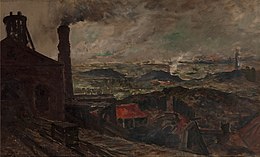Constantin Meunier
His work is a reflection of the industrial, social and political developments of his day and represents a compassionate and committed view of man and the world.
His family was poor and suffered from the negative economic impact caused by the Belgian Revolution which had taken place the year before Meunier's birth.
His first important painting, The Salle St Roch (1857), was followed by a series of paintings including A Trappist Funeral (1860), Trappists Ploughing (1863), in collaboration with Alfred Verwee, Divine Service at the Monastery of La Trappe (1871) and episodes of the German Peasants' War (1878),[5] as well as of Belgium's own historical Peasants' War.
[5] In 1885 he returned to sculpture and produced The Puddler, The Hammerman (1886), Firedamp (1889, Brussels Gallery), Le Débardeur (modeled 1885; many castings made 1889–1905), Ecce Homo (1891), The Old Mine-Horse (1891), The Mower (1892), The Glebe (1892), the monument to Father Damien at Louvain (1893), Puddler at the Furnace (1893), the scheme of decoration for the Botanical Garden of Brussels in collaboration with the sculptor Charles van der Stappen (1893), The Horse at the Pond, in the square in the north-east quarter of Brussels, and two unfinished works, the Monument to Labour and the Émile Zola monument, in collaboration with the French sculptor Alexandre Charpentier.
[5] He was one of the co-founders of the Société Libre des Beaux-Arts of Brussels and was a member of the International Society of Sculptors, Painters and Gravers.


